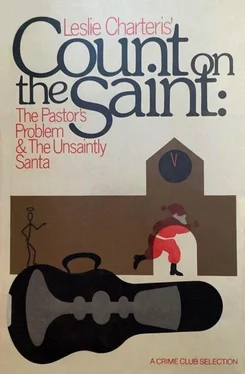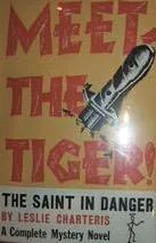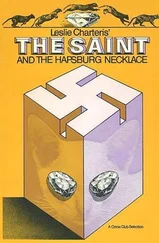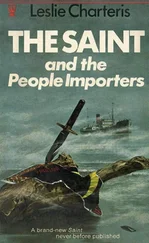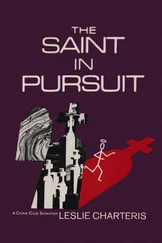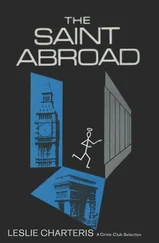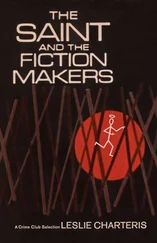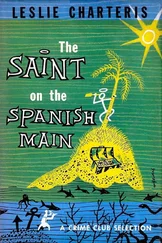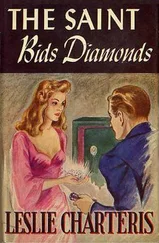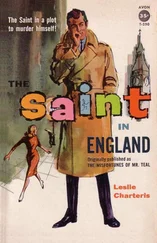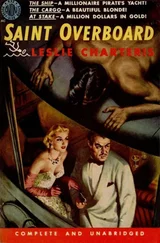All four stopped their meditations as a commotion erupted in the outer office, and turned as the door was thrown back and a man in brown overalls staggered in.
“Murder!” he panted. “He’s dead. I saw it!”
“What on earth are you blabbering about?” the manager demanded.
“I tell you, I saw it,” the porter repeated.
“Who’s been murdered?” Parsons asked sharply. “You’re not making sense, man.”
The porter shook himself as he fought to control his shock and regain his breath.
“Mr. Wakeforth, sir. He’s been shot. Murdered! I saw it.”
“Where?” The Saint’s voice sliced through the stillness that followed.
The porter swung around and noticed him for the first time.
“In the stock room. Just now. I saw it!”
“Good, then you can show me. Come along.”
Simon grasped the man by the arm and hustled him back to the door. He turned to the manager as he reached it. “Don’t sit there gawping, phone the police.”
In the corridor the porter suddenly stopped and began to struggle against the Saint’s grip.
“I’m not going back down there!”
“Yes, you are,” Simon told him firmly. “Don’t worry, I’ll hold your hand. Pull yourself together. Where is the stock room?”
The authority in his voice was not to be denied, and the porter stopped resisting and managed to get a hold on himself.
“Ground floor at the rear. I ran up the stairs, but there’s a service lift.”
The elevator was at the end of the passage, and Simon hustled the porter to it and bundled him inside.
The iron cage descended with infuriating slowness. The lower they went, the more the porter’s agitation increased, and when they finally stopped he pressed himself into a corner and refused to budge. The Saint let him stay where he was.
There was no need to search for the body. Stanton Wakeforth lay spread-eagled on the floor a few feet from the lift. There was a neat round hole in the breast pocket of his jacket where the bullet had entered, and a crimson stain that oozed and spread from beneath him.
The Saint knelt beside the body, and his experienced eye told him all he needed to know. The scorch marks around the wound showed that the gun had been fired at point-blank range, and death had come so quickly that the magnate’s features still seemed to be contorted in anger rather than fear.
Clutched in the left hand was a scrap of paper, and Simon had to open the fingers to extract it. At first he thought it was gift-wrapping paper, and then its real purpose dawned. It was part of a Christmas cracker.
The stock room covered a large area, and nearly all of it was stacked to the ceiling with crates and boxes. On one side was an open loading bay leading to a service road which ran behind the store. The Saint knew it was no use now to hunt for the murderer. It must have been simple for him to get in and hide among the crates until Wakeforth arrived, and just as easy to get away again afterwards without being seen.
He walked back to the lift and pressed the top-floor button.
“Tell me what happened,” he said to the porter as the lift slowly rose.
“I was checking the inventory of the last delivery when I see Mr. Wakeforth come out of the lift. Then this figure steps out in front of him and holds out a cracker. Mr. Wakeforth tries to pull it away from him, and then there’s a bang and he’s dead. Shot!”
“What did this man look like?”
The porter could not stop trembling. His fingers dug into the Saint’s shoulder, and his voice was little above a croak.
“I told you, I saw it. It wasn’t a man. It was Father Christmas!”
What the Chronicle’s front-page headline lacked in syntax it made up for in dramatic effect.
SANTA KILLER STRIKES AGAIN!
Simon Templar propped the paper against the coffeepot and read the story during breakfast.
The killing of Sir Basil Lazentree had happened too late for the following morning’s papers, but the murder of Stanton Wakeforth could not have been better timed if the editor had committed it himself.
Two murders within twenty-four hours and half a mile of each other, both of important people, both killed by a man disguised as Father Christmas, and both with Simon Templar in the vicinity: the story had everything any news-hungry editor ever dreamt of.
There was an account of each murder plus potted biographies of both victims. Everyone but the cat appeared to have been interviewed, and there was a spread of pictures of every person and place in any way involved.
The Saint reviewed his own notices critically. For once the quotes were accurate, but he thought it was time the press took a new portrait for their files. The picture of Nutkin, however, was an accurate likeness, the photographer having managed to catch him looking both arrogant and angry as he shouldered his way through the throng of reporters outside the department store.
There are certain moments which transcend description, when words become not only superfluous but positively obstructive to a clear understanding of the emotions they seek to describe. The look on Superintendent Nutkin’s face when he marched importantly into the manager’s office and found himself confronted by the Saint had been one such moment. It was like the expression of a monarch who, after walking grandly up the aisle to be crowned, finds someone already sitting on his throne.
“What are you doing here?” he almost shouted.
“Waiting for you, like everybody else, Mr. Nuthatch—”
“Nutkin!”
“—and before you go out on a limb and I have to saw it off,” Simon continued kindly, “we were all here together while Brother Wakeforth was being promoted to the Great Board Room in the sky. So let me warn you that anything you say may be taken down and used in evidence of probable paranoia.”
Once he had recovered from the shock and reluctantly accepted that the Saint’s alibi was not merely cast iron but made of titanium alloy, Nutkin had instituted the ritual known as Standard Procedure. The store had been cleared of customers and searched, the staff had been questioned and their statements taken, the stock room had been dusted for fingerprints and the body examined, photographed, and finally despatched to the morgue.
The net result of so much activity had been to establish that the murder of the store boss was in some way connected with the killing of the master of St. Enoch’s — a fact that had been fairly obvious from the moment the porter had given his description of the murder.
A clue that confirmed a probable link between the killings had been spotted by the Saint. Left to his own devices after being clearly exonerated of Wakeforth’s murder, he had ignored Nutkin’s instruction to leave the store and instead wandered up to the tycoon’s office. Browsing through his diary, he had found an entry: “ Lazentree 3.30.” The date was December 23, two days away. It was unexplained. He had bought Wakeforth’s secretary, who always accompanied her boss on visits to his stores, a calming brandy in a nearby pub, and she had identified the handwriting as his but had had no idea what the meeting was to have been about. Nutkin’s investigation did not seem to have noted it, but it had made the Saint somewhat curious about the connection of Stanton Wakeforth with St. Enoch’s.
One good thing to have resulted from Wakeforth’s death was that his last ukase had been forgotten, and Chantek and Ted had been allowed to go back to their jobs. The Saint was no longer concerned with the hung-over Santa, but Chantek was a different matter and had provided a delightful companion at dinner that night. Not yet having been thoroughly contaminated by the rising Western tide of feminine assertiveness, she happily and shamelessly deployed all the complaisant wiles which were the natural legacy of her other-worldly upbringing.
Читать дальше
